
Edinburgh Castle is a historic castle in Edinburgh, Scotland. It stands on Castle Rock, which has been occupied by humans since at least the Iron Age, although the nature of the early settlement is unclear. There has been a royal castle on the rock since at least the reign of David I in the 12th century, and the site continued at times to be a royal residence until 1633. From the 15th century, the castle's residential role declined, and by the 17th century it was principally used as military barracks with a large garrison. Its importance as a part of Scotland's national heritage was recognised increasingly from the early 19th century onwards, and various restoration programmes have been carried out over the past century and a half.

Stirling Castle, located in Stirling, is one of the largest and most important castles in Scotland, both historically and architecturally. The castle sits atop Castle Hill, an intrusive crag, which forms part of the Stirling Sill geological formation. It is surrounded on three sides by steep cliffs, giving it a strong defensive position. Its strategic location, guarding what was, until the 1890s, the farthest downstream crossing of the River Forth, has made it an important fortification in the region from the earliest times.

Brechin is a town and former Royal burgh in Angus, Scotland. Traditionally Brechin was described as a city because of its cathedral and its status as the seat of a pre-Reformation Roman Catholic diocese, but that status has not been officially recognised in the modern era. Nevertheless, the designation is often used, with examples being the City of Brechin and District Community Council, City of Brechin and Area Partnership, City of Brechin Civic Trust and Brechin City Football Club. Kinnaird Castle is nearby. Brechin is located slightly closer to Dundee than Aberdeen and is located on the A90 between the cities. It is the fourth largest settlement of Angus.

Rosslyn Chapel, formerly known as the Collegiate Chapel of St Matthew, is a 15th-century chapel located in the village of Roslin, Midlothian, Scotland.

St Giles' Cathedral, or the High Kirk of Edinburgh, is a parish church of the Church of Scotland in the Old Town of Edinburgh. The current building was begun in the 14th century and extended until the early 16th century; significant alterations were undertaken in the 19th and 20th centuries, including the addition of the Thistle Chapel. St Giles' is closely associated with many events and figures in Scottish history, including John Knox, who served as the church's minister after the Scottish Reformation.

King's College in Old Aberdeen, Scotland, the full title of which is The University and King's College of Aberdeen, is a formerly independent university founded in 1495 and now an integral part of the University of Aberdeen. Its historic buildings are the centrepiece of the University of Aberdeen's Old Aberdeen campus, often known as the King's or King's College campus.
Forss Water, known also as Forss River, has its source at the northern end of Loch Shurrey, at grid reference ND042568. About 13 kilometres north of its source the river flows into Crosskirk Bay and the Atlantic Ocean at ND029700. Crosskirk Bay is on the north coast of Great Britain and about 8 kilometres west of the burgh of Thurso, Caithness, in Highland, Scotland. The river marked the eastern extent of the Clan Mackay raid in the Sandside Chase of 1437.
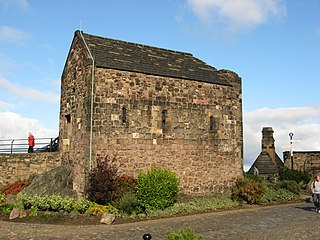
St Margaret's Chapel, in Edinburgh Castle, is the oldest surviving building in Edinburgh, Scotland. An example of Romanesque architecture, it is a category A listed building. It was constructed in the 12th century, but fell into disuse after the Reformation. In the 19th century the chapel was restored and today is cared for by the St Margaret's Chapel Guild.

Douglas is a village in South Lanarkshire, Scotland. It is located on the south bank of the Douglas Water and on the A70 road that links Ayr, on the West coast of Scotland, to Edinburgh on the East, around 12 miles south west of Lanark. The placename is of Gaelic origin, derived from the Old Gaelic dub and glais, meaning "dark stream", in reference to the Douglas Water. The Douglas family took this name when their ancestors settled here in the 12th century.
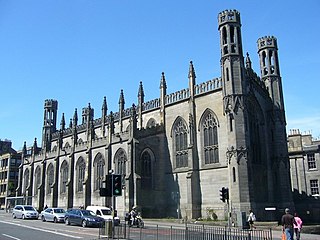
St Paul's and St George's Church is an evangelical church of the Scottish Episcopal Church in central Edinburgh, Scotland. It is located on the corner of Broughton Street and York Place in the east end of Edinburgh's New Town, and is protected as a category A listed building.

The Collegiate Church of St Mary the Virgin is a Church of Scotland parish church in Haddington, East Lothian, Scotland.

Broubster is a village in Highland, Scotland. Near Broubster, there is a Bronze Age megalithic arrangement. Ten stones remain of an original set of approximately 36. The arrangement is similar to a larger arrangement at Achavanich.
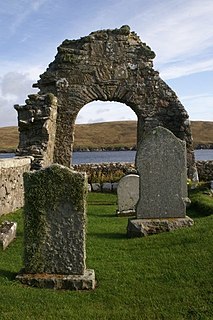
Sandsting is a parish in the West Mainland of Shetland, Scotland, forming a southern arm of the Walls Peninsula. After the parish of Aithsting was annexed into Sandsting in the sixteenth century, it became known as Sandsting and Aithsting parish.
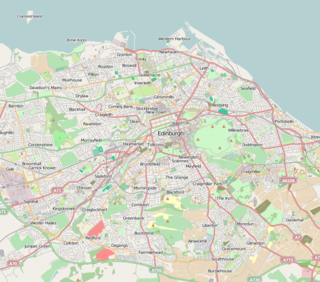
The Palace of Holyroodhouse, commonly referred to as Holyrood Palace or Holyroodhouse, is the official residence of the British monarch in Scotland. Located at the bottom of the Royal Mile in Edinburgh, at the opposite end to Edinburgh Castle, Holyroodhouse has served as the principal royal residence in Scotland since the 16th century, and is a setting for state occasions and official entertaining.
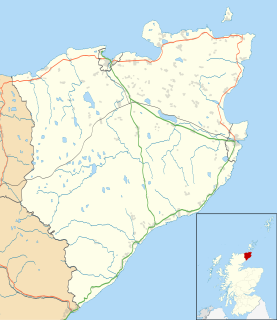
Crosskirk is a small remote hamlet, overlooking Crosskirk Bay, in Caithness, Scottish Highlands and is in the Scottish council area of Highland.

The Cathedral of Tarragona is a Roman Catholic church in Tarragona, Catalonia, Spain. The edifice is located in a site previously occupied by a Roman temple dating to the time of Tiberius, a Visigothic cathedral, and a Moorish mosque. It was declared a national monument in 1905.

St Oran's Chapel (Odhráin/Orain/Odran) is a medieval chapel located on the island of Iona in the Inner Hebrides off the west coast of Scotland. Built in the 12th century, the chapel was dedicated to St Oran. St Oran's Chapel was a ruin until the chapel was restored during the same time as Iona Abbey. The chapel is protected as a part of the Iona monastic settlement scheduled monument.
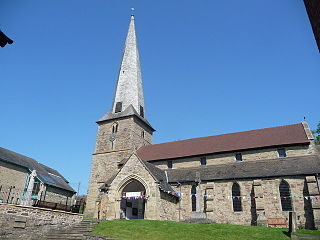
St Mary's Church is on Church Street, Cleobury Mortimer, Shropshire, England. It is an active Anglican parish church in the deanery of Ludlow, the archdeaconry of Ludlow, and the diocese of Hereford. Its benefice is united with those of six local parishes to form the Cleobury Benefice. The church is recorded in the National Heritage List for England as a designated Grade I listed building. It is notable for its shingled twisted spire.

Crosskirk Broch was a fortification near the present day hamlet of Crosskirk near Thurso, Caithness, Scotland. After thorough archaeological exploration it was destroyed in 1972 since the site had become unsafe due to sea erosion. The site was unusual in having a broch, a large circular fortification, built within an older promontory fortification with a ring wall and blockhouse.

St Patrick's Church is a Roman Catholic Parish church in the Cowgate part of Old Town, Edinburgh, Scotland. It was built from 1771 to 1774, and became a Catholic church in 1856. The facade of the church was designed by Reginald Fairlie in 1929. It is situated between South Gray's Close and St Mary's Street north of Cowgate and south of the Royal Mile. It is a category B listed building.





















